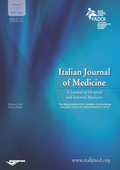Original Articles
27 February 2014
Vol. 9 No. 1 (2015)
Genetic predictors of response to treatment of chronic hepatitis C virus infection in patients from southern Italy

Publisher's note
All claims expressed in this article are solely those of the authors and do not necessarily represent those of their affiliated organizations, or those of the publisher, the editors and the reviewers. Any product that may be evaluated in this article or claim that may be made by its manufacturer is not guaranteed or endorsed by the publisher.
All claims expressed in this article are solely those of the authors and do not necessarily represent those of their affiliated organizations, or those of the publisher, the editors and the reviewers. Any product that may be evaluated in this article or claim that may be made by its manufacturer is not guaranteed or endorsed by the publisher.
2544
Views
1397
Downloads
586
HTML
Authors
Internal Medicine and Hepatology Unit, Salerno University of Medicine, Salerno, Italy.
Department of Molecular Medicine and Medical Biotechnologies, University of Naples Federico II, CEINGE - Advanced Biotechnologies, Naples, Italy.
Department of Molecular Medicine and Medical Biotechnologies, University of Naples Federico II, CEINGE - Advanced Biotechnologies, Naples, Italy.
Department of Molecular Medicine and Medical Biotechnologies, University of Naples Federico II, CEINGE - Advanced Biotechnologies, Naples, Italy.
Internal Medicine Department, Second University of Naples, Italy.
Internal Medicine Department, Liver Diseases Centre - Fatebenefratelli Hospital, Naples, Italy.
Gastroenterology and Endoscopy Department, Second University of Naples, Naples, Italy.
Department of Molecular Medicine and Medical Biotechnologies, University of Naples Federico II, CEINGE - Advanced Biotechnologies, Naples, Italy.
Internal Medicine and Hepatology Unit, Salerno University of Medicine, Salerno, Italy.
Supporting Agencies
none
Mario Masarone, Internal Medicine and Hepatology Unit, Salerno University of Medicine, Salerno
MD
Roberta Russo, Department of Molecular Medicine and Medical Biotechnologies, University of Naples Federico II, CEINGE - Advanced Biotechnologies, Naples
MD
Antonella Gambale, Department of Molecular Medicine and Medical Biotechnologies, University of Naples Federico II, CEINGE - Advanced Biotechnologies, Naples
MD
Concetta Langella, Department of Molecular Medicine and Medical Biotechnologies, University of Naples Federico II, CEINGE - Advanced Biotechnologies, Naples
MD
Luca Fontanella, Internal Medicine Department, Liver Diseases Centre - Fatebenefratelli Hospital, Naples
MD
Marco Romano, Gastroenterology and Endoscopy Department, Second University of Naples, Naples
MD
Achille Iolascon, Department of Molecular Medicine and Medical Biotechnologies, University of Naples Federico II, CEINGE - Advanced Biotechnologies, Naples
MD
Marcello Persico, Internal Medicine and Hepatology Unit, Salerno University of Medicine, Salerno
MD
How to Cite
Genetic predictors of response to treatment of chronic hepatitis C virus infection in patients from southern Italy. (2014). Italian Journal of Medicine, 9(1), 61-70. https://doi.org/10.4081/itjm.2014.443
PAGEPress has chosen to apply the Creative Commons Attribution NonCommercial 4.0 International License (CC BY-NC 4.0) to all manuscripts to be published.






